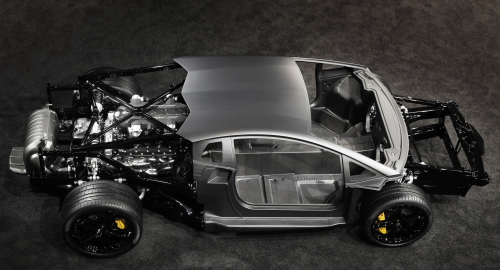

The successor to the Murciélago, the Aventador LP700-4 was unveiled at the 2011 Geneva Auto Show. It features a carbon fibre composite chassis, the bulk of which was produced using an Araldite resin system from Huntsman Advanced Materials. The resin was specially adapted for Lamborghini's ‘RTM-Lambo’ resin transfer moulding (RTM) process.
During the patented RTM-Lambo process used to produce the chassis, pre-formed carbon fibre reinforcements are impregnated with a precise amount of the Araldite resin. Moulds made of carbon fibre composite are used, rather than steel or aluminium, and the process is highly automated.
The Aventador’s chassis also includes epoxy foam sections, adding the space needed to create shapes without introducing unnecessary layers of carbon fibre. The foam also dampens noise and vibrations.
To meet all of Lamborghini's requirements, the resin must have a very low viscosity, sufficient-pot life and good fibre impregnation capabilities. It must be able to deliver the mechanical properties required to ensure the strength and torsional rigidity of the chassis.
“The Araldite resin system developed by Huntsman has been extremely well adapted for the ‘RTM-Lambo’ technique," reports Luciano De Oto, Head of the Lamborghini Advanced Composite Research Centre (ACRC). "It has excellent mechanical and curing properties and a suitable viscosity profile versus time, allowing us to meet rigorous performance and cost requirements.”
“To fulfil increasing production rates as we move forward with our strategy to deploy more carbon fibre in the future generations of our high performance cars, this RTM process is the answer,” he adds.
Lamborghini reports that the RTM-Lambo prociess offers a cost effective solution for the repeatable production of structural parts with mechanical and thermal performances comparable to autoclaved prepregs.
The Aventador LP700-4’s carbon composite chassis was designed, developed and manufactured at Lamborghini’s headquarters at Sant’Agata Bolognese, Italy. This carbon chassis is also expected to be an integral part of future Lamborghini models.




